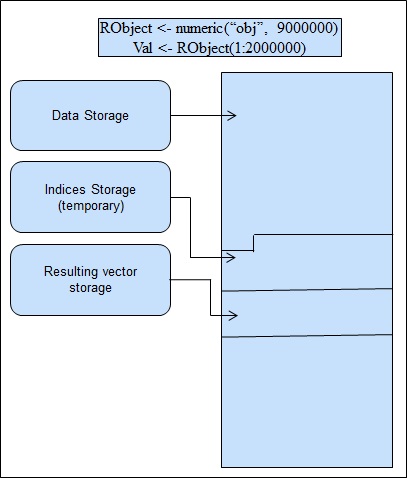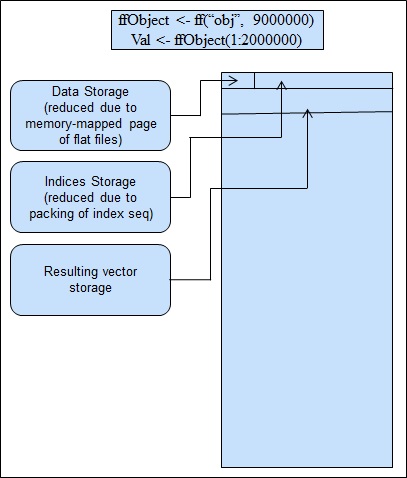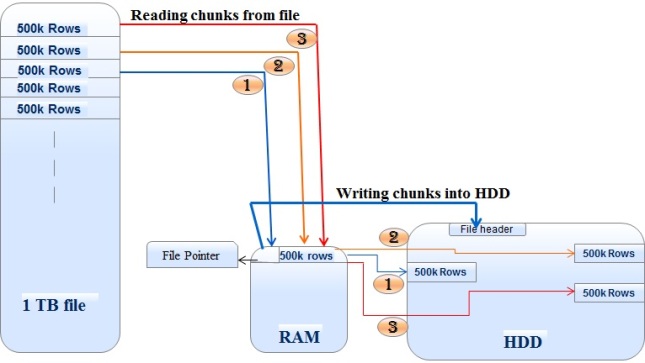Native R stores everything into RAM. For more, please visit R memory management. R objects can take memory upto 2-4 GB, depends on hardware configuration. Beyond this, it returns “Error: cannot allocate vector of size ……” and leaving us handicapped to work with big data using R.

Data Storage with standard R Object
Thanks to R open source, group of scholars who continuously strives in creating R packages which help us to work effectively with big data.
ff package developed by Daniel Adler, Christian Gläser, Oleg Nenadic, Jens Oehlschlägel, Walter Zucchini and maintained by Jens Oehlschlägel is designed to overcome this limitation. It uses other media like hard disk, CD and DVD to store the native binary flat files rather than its memory. It also allows you to work on very large data file simultaneously. It reads the data files into chunk and write that chunk into the external drive.

Data Storage with ff
Read csv file using ff package
>options(fftempdir = [Provide path where you want to store binary files])
>file_chunks <- read.csv.ffdf(file=”big_data.csv”, header=T, sep=”,”, VERBOSE=T, next.rows=500000, colClasses=NA)
It read big_data csv file chunk by chunk as specified in next.rows. It reads the chunks and write binary files in any external media and store the pointer of file in RAM. It perform this step until csv file left with no chunks.

Functioning of ff package
In the same way, we can write csv or other flat files in chunk. It
reads chunk by chunk from HDD or any other external media and write it
into csv or other supported format.>write.csv.ffdf(File_chunks, “file_name.csv”)
ff provides us the facility with ffbase package to implement all sorts of functions like joins, aggregations, slicing and dicing.
>Merged_data = merge(ffobject1, ffobject2, by.x=c(“Col1″, “Col2″), by.y=c(“Col1″,”Col2″), trace=T)
Merge function of ff, ffbase package works similar as it worked for data frame but it allows inner and left join only.
>library(“doBy”)
>AggregatedData = ffdfdply(ffobject, split=as.character(ffobject$Col1), FUN=function(x) summaryBy(Col3+Col4+Col5 ~ Col1, data=x, FUN=sum))
To perform aggregation, I used summaryBy function which is available under doBy package. In the above ffdfdply function we split the data on the basis of some key column. If key column contains combination of 2 or more fields, we can generate key columns using ikey function
>ffobject$KeyColumn <- ikey(ffobject[c("Col1","Col2","Col3")])
With all sorts of advantages like working with big data and less dependency on RAM, ff has few limitations, such as
1. Sometimes, we need to compromise with the speed when we are performing complex operations with huge data set.
2. Development is not easier using ff.
3. Need to care about flat files that stores in the disk otherwise your HDD or external media left with little or no space.
#####################
Opening Large CSV Files in R
Before heading home for the holidays, I had a large data set (1.6 GB with over 1.25 million rows) with columns of text and integers ripped out of the company (Kwelia) Database and put into a .csv file since I was going to be offline a lot over the break. I tried opening the csv file in the usual way:However it never finished even after letting it go all night. I also tried reading it into a SQLlite database first and reading it out of that, but the file was so messy it kept coming back with errors. I finally got it read in to R by using the ff package and the following code:
Latest Jobs in Fashion Industry in Delhi, NCR | 9250406614
ReplyDelete
DeleteChatGPT
In R, the ff and ffbase packages are powerful tools for performing big data analysis, especially when dealing with datasets that are too large to fit into memory. Big Data Projects For Final Year These packages allow for efficient handling, manipulation, and analysis of large-scale data using file-backed data structures. Machine Learning Projects for Final Year
It’s great to come across a blog every once in a while that isn’t the same out of date rehashed
ReplyDeletematerial. Fantastic read.
Java Training in Chennai |Best
Java Training in Chennai
C C++ Training
in Chennai |Best C C++ Training Institute in Chennai
Data science Course
Training in Chennai |Best Data Science Training Institute in Chennai
RPA Course
Training in Chennai |Best RPA Training Institute in Chennai
AWS Course Training
in Chennai |Best AWS Training Institute in Chennai
Devops Course Training
in Chennai |Best Devops Training Institute in Chennai
Selenium Course Training in
Chennai |Best Selenium Training Institute in Chennai
Java Course Training in Chennai |
Best Java Training Institute in Chennai
Hello, I read your blog occasionally, and I own a similar one, and I was just wondering if you get a lot of spam remarks? If so how do you stop it, any plugin or anything you can advise? I get so much lately it’s driving me insane, so any assistance is very much appreciated.
ReplyDeleteMachine Learning Training in Chennai | Machine Learning Training Institute in Chennai
Devops Training in Chennai | Devops Training Institute in Chennai
Data Science Training in Chennai | Data Science Course in Chennai
Selenium Training in Chennai | Selenium Training Institute in Chennai
Blue Prism Training in Chennai | Blue Prism Training Institute in Chennai
PHP Training in Chennai | PHP Training Institute in Chennai
I am impressed by the information that you have on this blog. It shows how well you understand this subject.
ReplyDeleteData Analytics Courses
Nice Post Thanks For Sharing
ReplyDeleteBig data analysis
I have been searching to find a comfort or effective procedure to complete this process and I think this is the most suitable way to do it effectively.
ReplyDeletemachine learning course in bangalore
This comment has been removed by the author.
ReplyDeleteThis comment has been removed by the author.
ReplyDeleteohh what a great topic. It help me a lot.
ReplyDeleteYou will get an introduction to the Python programming language and understand the importance of it. How to download and work with Python along with all the basics of Anaconda will be taught. You will also get a clear idea of downloading the various Python libraries and how to use them.
Topics
About ExcelR Solutions and Innodatatics
Do's and Don’ts as a participant
Introduction to Python
Installation of Anaconda Python
Difference between Python2 and Python3
Python Environment
Operators
Identifiers
Exception Handling (Error Handling)
This article really compertable for us thaks for shearing
ReplyDeleteThank you for sharing valuable information.
ReplyDeleteYou can also check this links. Hope it can help you and your friend, who is looking for job change.
If you have up to 10 years experience, then you can come for interview round. For more details you can direct call on this number @ +91 9250406614.
It is totally free service. Free Free Free !!
Jd for Group Manager (Oil and Gas research) - Gurgaon
Thank you.
good article Surya Informatics
ReplyDeleteI have to voice my passion for your kindness giving support to those people that should have guidance on this important matter.
ReplyDeleteAI training chennai | AI training class chennai
Cloud computing training | cloud computing class chennai
python training in noida sector 15
ReplyDeletesap sd training center in noida
linux training center in noida sector 62
Email marketing training course in noida sector 15
salesforce training in noida sector 63
openstack training in noida sector 15
digital marketing training center in noida sector 16
ReplyDeleteUi Path training center in Noida
digital marketing training center in noida sector 18
linux training center in noida sector 15
python training in noida sector 62
Email marketing training course in noida sector 62
ReplyDeletedevops training in center noida
blue prism training center in noida
cloud computing training in noida sector 15
hadoop training center in noida
python training in noida sector 15
ReplyDeleteI was basically inspecting through the web filtering for certain data and ran over your blog. I am flabbergasted by the data that you have on this blog. It shows how well you welcome this subject. Bookmarked this page, will return for extra. data science course in jaipur
Offering the most effective collection of knowledge in real-time to students through experts and creating them into industry Python Training in Hyderabad with the help of experts from AI Patasala.
ReplyDeletePython Training Hyderabad